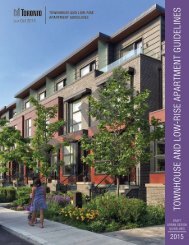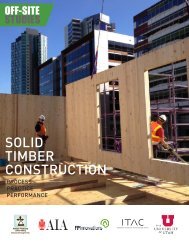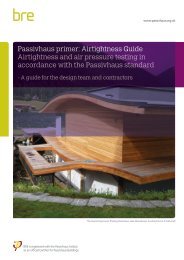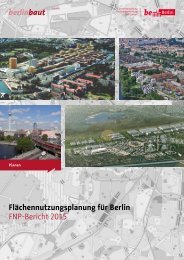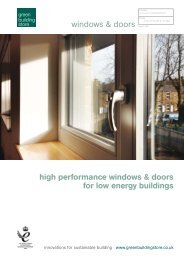TRUE URBAN SPIRIT
b008379b
b008379b
Create successful ePaper yourself
Turn your PDF publications into a flip-book with our unique Google optimized e-Paper software.
A BUSINESS, SCIENCE AND RESEARCH HUB<br />
3.1<br />
As a biotechnology and ICT location, Vienna has<br />
become a member of Europe’s elite locations;<br />
since 1991, the level of employment in the field of<br />
knowledge-intensive business and financial services<br />
– so essential for urban agglomerations –<br />
has increased by 66 percent. As a result, Vienna<br />
has established itself among the top ten of European<br />
metropolises in this sector. For many years,<br />
the city has been a top player among worldwide<br />
conference destinations; Vienna’s office market<br />
offers one of the best price/value ratios in Europe;<br />
and Vienna is an interesting investment target<br />
for international enterprises. In addition, Vienna<br />
is a smart city that scores with its high level of<br />
urban technologies and investment options for<br />
research- and technology-driven companies.<br />
While the number of enterprises and employees<br />
in the production sector has been declining, the<br />
economic value added has remained unaltered. At<br />
the same time, a successful internationalisation<br />
push as the result of high productivity and innovative<br />
skills can be observed. The export orientation<br />
of Vienna’s industrial enterprises is conti n-<br />
uously increasing and performs outstandingly<br />
compared to other parts of the country. Moreover,<br />
Vienna is the economic centre of a prospering<br />
urban region; public services and administrative<br />
institutions play a correspondingly important role.<br />
In brief: structural change towards a knowledge<br />
and service society is in full swing.<br />
Technology and export-oriented production enterprises<br />
and companies of the knowledge and<br />
service sector present specific requirements<br />
regarding their home city and location within it.<br />
Networking and cluster formation are of key<br />
importance for technology-intensive and value<br />
creation-oriented industries; universities, universities<br />
of applied sciences and research institutions<br />
become incubators for spin-offs of corresponding<br />
spatial demand. Due to minimal noise<br />
and pollutant emissions, modern production<br />
enterprises may also be suitable for urban locations;<br />
however, goods production equally needs<br />
large, contiguous tracts of land with excellent<br />
transport connections. Offices and commercial<br />
enterprises necessitate both inner-city and<br />
pe r ipheral locations (the latter obviously with ex -<br />
cellent transport links); in addition, commerce<br />
requires sufficiently dimensioned logistics sites.<br />
The creative industries and small companies are<br />
interested in affordable premises close to home,<br />
good public transport connections and a cre -<br />
ative urban environment.<br />
City tourism is a growth market the world over.<br />
At the moment, tourism contributes roughly<br />
5 percent to Vienna’s gross regional product, with<br />
the number of overnight stays strongly on the<br />
rise. With over 1,000 national and international<br />
conferences annually, Vienna is one of the three<br />
leading congress cities on a global scale. However,<br />
tourism not only means customers and<br />
turnover for the food service industry, retail trade<br />
and high-quality hotel projects, but also contributes<br />
significantly to the authentic positioning<br />
of Vienna as an international metropolis, helps<br />
to preserve Vienna’s impressive cultural heritage<br />
and further develops contemporary culture.<br />
Agriculture plays a special role in this context –<br />
Vienna is the only worldwide metropolis with<br />
an agricultural sector of noteworthy dimensions.<br />
While the number of workers in the sector is<br />
relatively small (4,000 persons), the areas under<br />
cultivation is sizable. Some crops, such as wine,<br />
fruit and vegetables or organic farming, not only<br />
turn a profit but at the same time fulfil other<br />
important functions like identity creation, supply<br />
with fresh produce, provision with urban leisure<br />
opportunities and ecological aspects. A binding<br />
basis for agricultural development perspectives is<br />
provided by the Agricultural-structural Development<br />
Plan . The plan contains a delimitation of<br />
all areas reserved for agriculture and proposes<br />
measures to ensure the continued cultivation of<br />
these zones.<br />
The needs and marked dynamism of modern<br />
urban economies create a volatile environment<br />
for urban planning and development, in which the<br />
interests of enterprises, research and university<br />
institutions, businesses and land owners must<br />
be negotiated and balanced as smoothly as possible.<br />
However, the variety and competitive<br />
dynamics of a modern economy also widen the<br />
leeway for action and the possibilities to exert<br />
influence. Cities and their planners today can join<br />
forces with enterprises and universities to develop<br />
or evolve attractive new venues for business<br />
and research. Vienna has shown the way in recent<br />
years. Neu Marx in the 3 rd municipal district<br />
constitutes an attractive new venue for companies<br />
and research facilities: Campus Vienna Biocenter<br />
focuses internationally renowned research institutions<br />
and companies active in life sciences;<br />
close by, on the premises of the former slaughterhouse,<br />
a media and ICT cluster is taking shape.<br />
Around Muthgasse in the 19 th municipal district, a<br />
public initiative provided the launching pad for<br />
one of Europe’s biggest biotechnology clusters.<br />
Close fine-tuning and scheduling of the time horizons<br />
for the construction of the new Vienna University<br />
of Economics and Business complex, the<br />
completion of Viertel Zwei and the development<br />
along the trajectory of the U2 Underground line<br />
between Praterstern and Donaumarina allowed<br />
for synchronised expansion that has proved of<br />
benefit both for the surrounding area and the<br />
university and business location per se. Finally,<br />
the Siemens-Allissen urban development zone<br />
has produced a political flagship investment, with<br />
75



